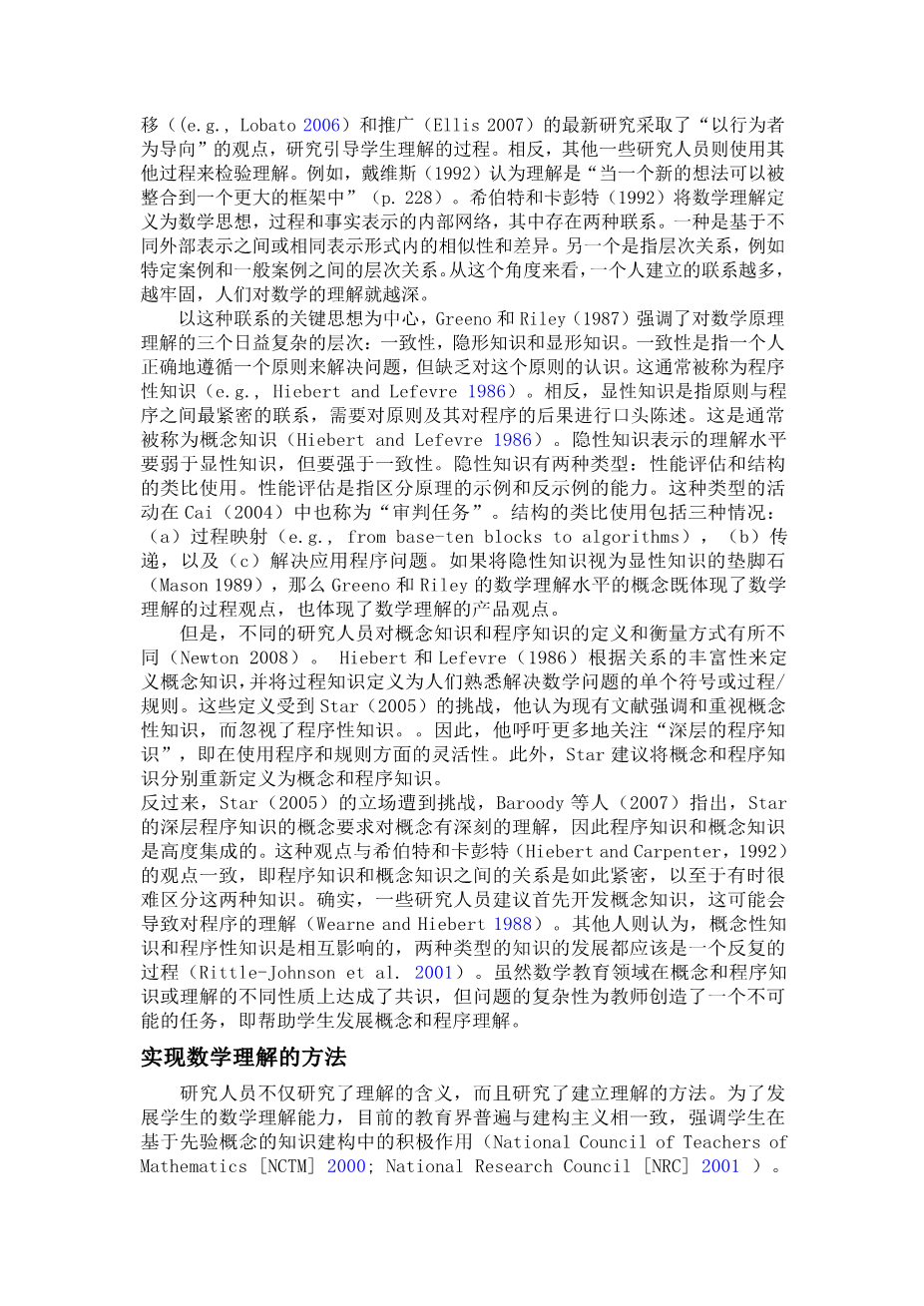On mathematical understanding: perspectives of experienced Chinese mathematics teachers
Jinfa Cai1 · Meixia Ding2
Published online: 15 October 2015
copy; Springer Science Business Media Dordrecht 2015
Abstract Researchers have long debated the meaning of mathematical understanding and ways to achieve mathematical understanding. This study investigated experienced Chinese mathematics teachersrsquo; views about mathematical understanding. It was found that these mathematics teachers embrace the view that understanding is a web of connections, which is a result of continuous connection making. However, in contrast to the popular view which separates understanding into conceptual and procedural, Chinese teachers prefer to view understanding in terms of concepts and procedures. They place more stress on the process of concept development, which is viewed as a source of studentsrsquo; failures in transfer. To achieve mathematical understanding, the Chinese teachers emphasize strate- gies such as reinventing a concept, verbalizing a concept, and using examples and comparisons for analogical reasoning. These findings draw on the perspective of classroom practitioners to inform the long-debated issue of the meaning of mathematical under- standing and ways to achieve mathematical understanding.
Keywords Mathematical understanding · Achieving mathematical understanding · Experienced teachers · Chinese teachers · Perspective of classroom practitioners
Mathematical understanding is a critical topic that has been extensively studied at least since Brownell (1935). Although there is an abundance of theories and research on the meaning of mathematical understanding and ways to achieve it, the findings have been inconsistent, which points to the complexity of this notion. For example, researchers have categorized mathematical understanding into conceptual understanding and procedural understanding (Hiebert and Carpenter 1992; Rittle-Johnson et al. 2001; Skemp 1976). Yet,there is some disagreement about what these terms mean and how they interact with each other. In addition, although mathematical understanding is generally viewed as an eventual goal of learning, there are philosophically and practically different approaches to achieving it (Cobb 1994; Meel 2003). Indeed, empirical evidence shows that many students around the world lack mathematical understanding (Cai 2004; Liet al. 2008; Torbeyns et al. 2009; Trends in International Mathematics and Science Study [TIMSS] 2003, 2007). This state of affairs calls for continued attention to the issue of mathematical understanding.
Existing studies of mathematical understanding have mainly represented researchersrsquo; perspectives (Davis 1992; Hiebert and Carpenter 1992; Pirie and Kieren 1992, 1994; Richland et al. 2012; Simon 2006). Given the important role of teachers in supporting learning, Richland et al. (2012) proposed an urgent agenda of studying teachersrsquo; episte- mologies in order to develop effective instructional routines that would facilitate studentsrsquo; mathematical understanding. Taking an international perspective, this study explores experienced Chinese teachersrsquo; views of mathematical understanding, aiming to understand their views on the meaning of mathematical understanding and ways to achieve it.
Theoretical considerations
Meaning of mathematical understanding
Mathematical understanding has been viewed both as a process of achieving understanding and as the result of having achieved understanding. In fact, in both Chinese and English the word “understanding” has dual meanings being both the present participle of the verb “to understand” (process) and a gerund acting as a noun (product). Some researchers have used a process lens to examine mathematical understanding. For example, Greeno (1978) stated that understanding is a process leading to “a structure that represents the relations among components of the idea that is understood” (p. 267). Pirie and Kieren (1992, 1994) viewed mathematical understanding as a dynamic and continual process of organizing onersquo;s knowledge structure. More recent research on student transfer (e.g., Lobato 2006) and generalization (Ellis 2007) has taken an “actor-oriented” view, studying the processes that lead to studentsrsquo; understanding. In contrast, some other researchers have used a product lens to examine understanding. For example, Davis (1992) perceived understanding as “when a new idea can be fitted into a larger framework of previously assembled ideas” (p. 228). Hiebert and Carpenter (1992) defined mathematical understanding as an internal network of representations of mathematical ideas, procedures, and facts, in which there are two kinds of connections. One is based on the similarities and differences between dif- ferent external representations or within the same form of representation. The other refers to hierarchical relationships such as the ones between specific and general cases. From this perspective, the more and stronger the connections one constructs, the deeper the mathe- matical understanding one achieves.
Centering on
剩余内容已隐藏,支付完成后下载完整资料


英语译文共 5 页,剩余内容已隐藏,支付完成后下载完整资料
资料编号:[410437],资料为PDF文档或Word文档,PDF文档可免费转换为Word


